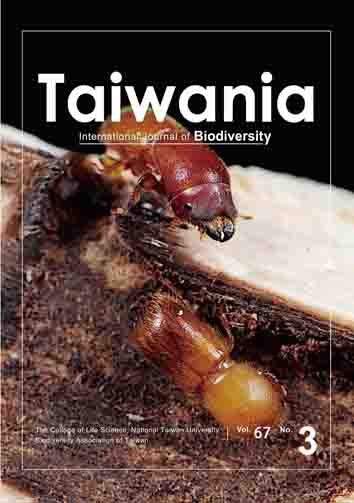Research Paper
Agriculture communities’ perception and willingness to pay for eradicating Xanthium strumarium L: A step towards the progressive decrease of economic and biodiversity loss
Rafi Ullah, Nasrullah Khan, Zoya Baig, Nabila
Published on: 13 June 2022
Page: 341 - 350
DOI: 10.6165/tai.2022.67.341
Abstract
Xanthium strumarium L. is native to North America and rapidly spreading in Khyber Pakhtunkhwa (KP) Pakistan as an alien invasive plant species (AIPs) and possess a severe threat to crops. Hence this study was conducted to assess socioeconomic impacts on agriculture, livestock, and biodiversity along with the mode of invasion, spread, and willingness to pay for its eradication in selected areas of KP Pakistan. Methods: Three divisions of Khyber Pakhtunkhwa province , i.e. Malakand, Peshawar, and Hazara, were selected for the study. The respondents were divided into two categories, i.e., agricultural and non-agricultural. The respondent's information was collected using a closed-ended questionnaire and semi-structured interview. The data were analyzed and interpreted by tabulation in excel 2010, and variation was tested using online chi-square tests. Results: Most respondents believed that the plant preferred to grow on the roadside and wasteland, affecting crops, especially maize, and infesting the areas for more than 20 years with regular and timely increased infestation. Livestock animals are affected severely in health and products. The chi-square test results indicated that the agricultural communities were affected more than non-agricultural communities. The invasion of the species has affected people's livelihood to the extent that they would spend money on its eradication/control. Biodiversity effects were severe in all the areas, as revealed by decreased species richness index in invaded sites. Conclusions: We concluded that cash crops and communities' economic value suffered severely from the invasion of X. strumarium, and therefore integrated management is needed for its control and eradication.
Keyword: Agriculture, Live-stock, Invasive alien species, Xanthium strumarium, respondents
Literature Cited
Alberini, A. and J.-R. Kahn (eds.) 2006. Handbook on contingent valuation, Edward Elgar Publishing, London.
DOI: 10.4337/9781845427917View Article
Alfarhan, A.-H. 2002. Dispersal mechanisms of flowering plants in the Central Region of Saudi Arabia. J. King Abdulaziz Univ. Meteorol. Environ. Arid Land Agric. Science 13(1): 17?39.
DOI: 10.4197/met.13-1.2View Article
Google Scholar
Ali, A., T.-A. Khan and A. Ahmad. 2018. Analysis of climate data of Khyber Pakhtunkhwa, Pakistan. International Research Journal of Engineering and Technology 5(5): 4266?4283.
Amini, R., S. Izadkhah, A.-D. Mohammadinasab and Y. Raei. 2014. Common cocklebur (Xanthium strumarium L.) seed burial depth affecting corn (Zea mays L.) growth parameters. Int. J. Biosci. 4: 164?170.
DOI: 10.12692/ijb/4.3.164-170View Article
Google Scholar
Arrow, K., R. Solow, P. Portney, E. Leamer, R. Radner and H. Schuman. 1993. Contingent Valuation Methodology Report’, Report of the NOAA Panel on Contingent Valuation. Fed. Reg. 58, Resources for the Future, Washington, pp. 4602?4614.
Bardsley, D. and E.-G. Jones. 2006. Stakeholders perception of the impacts of invasive exotic plants species in the Mediterranean Basin, Geojournal 65(3): 199–210.
DOI: 10.1007/s10708-005-2755-6View Article
Google Scholar
Br?uer, I. 2003. Money as an indicator: To make use of economic evaluation for biodiversity conservation. Agric. Ecosyst. Environ. 98(1-3): 483–491.
DOI: 10.1016/S0167-8809(03)00107-5View Article
Google Scholar
Charles, H. and J.-S. Dukes. 2007. Impacts of invasive species on ecosystem services, in Nentwig, W. (ed.), Biological invasions 193: 217–237. Springer-Verlag Berlin Heidelberg, New York.
DOI: 10.1007/978-3-540-36920-2_13View Article
Google Scholar
Chikuruwo, C., M. Masocha, A. Murwira and H. Ndaimani. 2017. Predicting the suitable habitat of the invasive Xanthium strumarium L. in Southeastern Zimbabwe. Appl. Ecol. Environ. Res. 15(1): 17–22.
DOI: 10.15666/aeer/1501_017032View Article
Google Scholar
Wasim, A. 2018. National Assembly green-lights Fata-KP merger bypassing 'historic' bill. From http://Dawn.com. 2018-05-24; Retrieved 2018-06-03.
Debnath, B., A. Debnath and C. Paul. 2015. Diversity of invasive alien weeds in the major roadside areas of Tripura and their effect and uses. J. Chem. Biol. Phys. Sci. 5: 3091–102.
Dekker, J. 2011. Evolutionary Ecology of Weeds. Class use version. Weeds-R-US USA 2011.
Deo, R.-C. and M. ?ahin. 2015. Application of the Artificial Neural Network model for prediction of monthly Standardized Precipitation and Evapotranspiration Index using hydrometeorological parameters and climate indices in eastern Australia. Atm. Res. 161: 65–81.
DOI: 10.1016/j.atmosres.2015.03.018View Article
Google Scholar
Emerton, L., J. Bishop and L. Thomas. 2006. Sustainable Financing of Protected Areas: A global review of challenges and options, IUCN, Gland, Switzerland and Cambridge, UK.
DOI: 10.2305/IUCN.CH.2005.PAG.13.enView Article
Gotelli, N.-J. and A. Chao. 2013. Measuring and estimating species richness, species diversity, and biotic similarity from sampling data. In: Levin, S.A. eds. Encyclopedia of Biodiversity (2nd edtion) 195-211 pp. Academic Press
DOI: 10.1016/B978-0-12-384719-5.00424-XView Article
Google Scholar
Hashim, S. and K.-B. Marwat. 2002. Invasive weeds a threat to the biodiversity: a case study from Abbottabad District, N-W Pakistan. Pak. J. Weed Sci. Res. 8: 1–12.
Hussain, Z., K.-B. Marwat, J. Cardina and I.-A. Khan. 2014. Xanthium strumarium L. impact on corn yield and yield components. Turk. J. Agric. For. 38: 39-46.
DOI: 10.3906/tar-1210-53View Article
Google Scholar
Hussain, Z., K.-B. Marwat, M.-A. Khan, S. Hashim and T. Bakht. 2013. How the competition of Xanthium strumarium L. affects the phonological characters of maize crop. Pak. J. Bot. 45: 1883–1887.
Kamboj, A. and A.-K. Saluja. 2010. Phytopharmacological review of Xanthium strumarium L. (cocklebur). Int. J. Green. Pharm. 4(3): 129–139.
DOI: 10.4103/0973-8258.69154View Article
Google Scholar
Kaur, B., S. Bhatia and K.-K. Sharma. 2014. Diversity and impact of invasive alien plant species of family Asteraceae in Jammu district (Jammu and Kashmir, India). Int. J. Interdiscip. Multidiscip. Stud. 1: 51–62.
Khan, A.N. 2013. Analysis of 2010. flood causes, nature and magnitude in the Khyber Pakhtunkhwa, Pakistan. Nat. Hazards 66(2): 887–904.
DOI: 10.1007/s11069-012-0528-3View Article
Google Scholar
Kitula, A.-G.N. 2006. The environmental and socioeconomic impacts of mining on local livelihoods in Tanzania: A case study of Geita District. J. Clean. Prod. 14(3-4): 405–414.
DOI: 10.1016/j.jclepro.2004.01.012View Article
Google Scholar
Law, M.-C. 2008. Willingness to pay for the control of water hyacinth in an urban environment of South Africa’, Master’s thesis, Rhodes University.
Lehrer, D., N. Becker and P. Kurtiel. 2013. The Value of Coastal Sand Dunes as a Measure to Plan an Optimal Policy for Invasive Plant Species: The Case of the Acacia saligna at the Nizzanim LTER Coastal Sand Dune Nature Reserve, Israel. In: Mart?nez, M. et al. (eds) Restoration of Coastal Dunes. Springer Series on Environmental Management. Springer, Berlin, Heidelberg. Springer Series on Environmental Management, 273–288 pp.
DOI: 10.1007/978-3-642-33445-0_17View Article
Google Scholar
Love, D. and P. Dansereau. 1959. Biosystematic studies on Xanthium: taxonomic appraisal and ecological status. Can. J. Bot. 37(2): 173–208.
DOI: 10.1139/b59-016View Article
Google Scholar
Marwat, K.-B. 1993. Two new emerging weeds of N-W of Pakistan: Phragmites Australis (Cav.) Trin. ex Stud. (Cav.) Trin ex Stuet and Xanthium Strumarium L., posing threat to our future agriculture. PWSS Abstract 3: 50.
Marwat, K.-B., S. Hashim and H. Ali. 2010. Weed Management: A case study from northwest Pakistan. Pak. J. Bot. 42: 341–353.
Pejchar, L. and H. Money. 2009. Invasive species, ecosystem services and human well-being. Trends in Ecology and Evolution 24(9): 497–504.
DOI: 10.1016/j.tree.2009.03.016View Article
Google Scholar
Rashed-Mohasel, M.-H. and S.-K. Mousavi. 2007. Principles of Weed Management. Iran: Ferdowsi University of Mashhad Publication.
Saeed, A., A. Hussain, M.-I. Khan, M. Arif, M.-M. Maqbool, H. Mehmood and M.-S. Elshikh. 2020. The influence of environmental factors on seed germination of Xanthium strumarium L.: Implications for management. PloS one, 15(10): e0241601.
DOI: 10.1371/journal.pone.0241601View Article
Google Scholar
Sartorato, I., A. Berti and G. Zanin. 1996. Estimation of economic thresholds for weed control in soybean (Glycine max (L.) Merr.). Crop. Prot. 15(1): 63–68.
DOI: 10.1016/0261-2194(95)00114-XView Article
Google Scholar
Semenya, S.-S., M.-P. Tshisikhawe and M.-J. Potgieter. 2012. Invasive alien plant species: a case study of their use in the Thulamela Local Municipality, Limpopo Province, South Africa. Sci Res Essays 7(27): 2363–2369.
DOI: 10.5897/SRE11.2075View Article
Google Scholar
Ullah, R. and N. Khan. 2022. Xanthium strumarium L. an alien invasive species in Khyber Pakhtunkhwa (Pakistan): a tool for biomonitoring and environmental risk assessment of heavy metal pollutants. Arabian J. Sci. Eng. 47(1): 255–267.
DOI: 10.1007/s13369-021-05839-6View Article
Google Scholar
Ullah, R., N. Khan, K. Ali, M.E.H. Khan and D.-A. Jones. 2021. Screening of Xanthium strumarium (AIPS) Growing on Abandoned Habitats in Khyber Pakhtunkhwa, Pakistan: Perspectives for Phytoremediation. Appl. Sci. 11(24): 11704.
DOI: 10.3390/app112411704View Article
Google Scholar
Venkatachalam, L. 2004. The contingent valuation method: A review. Environ. Imp. Assess. A rev. 24(1): 89–124.
DOI: 10.1016/S0195-9255(03)00138-0View Article
Google Scholar
Weaver, S.-E. and M.-J. Lechowicz. 1983. The biology of Canadian weeds. 56. Xanthium strumarium L. Can. J. Plant Sci. 63(1): 211–25.
DOI: 10.4141/cjps83-021View Article
Google Scholar


